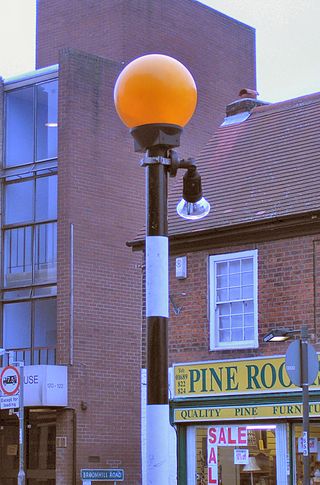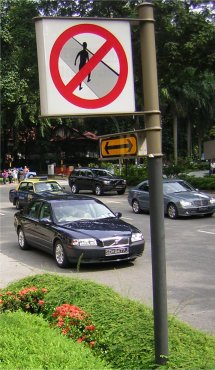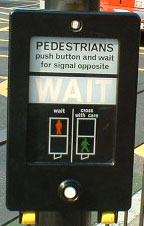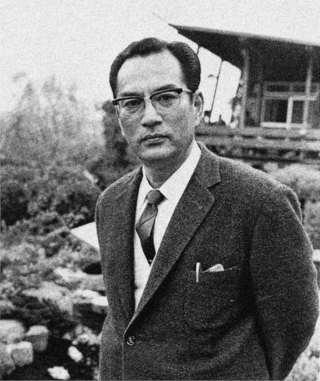
Traffic comprises pedestrians, vehicles, ridden or herded animals, trains, and other conveyances that use public ways (roads) for travel and transportation.

A pedestrian crossing is a place designated for pedestrians to cross a road, street or avenue. The term "pedestrian crossing" is also used in the Vienna and Geneva Conventions, both of which pertain to road signs and road traffic.

A pelican crossing, or archaically pelicon crossing, is a type of pedestrian crossing with traffic signals for both pedestrians and vehicular traffic, activated by call buttons for pedestrians, with the walk signal being directly across the road from the pedestrian. The design is also found in the Isle of Man, the Channel Islands, the island of Ireland, Indonesia and Australia. The crossings began to be phased out in Great Britain in 2016, being replaced with puffin crossings which have pedestrian signals above the call button rather than across the road.

A Belisha beacon is an amber-coloured globe lamp atop a tall black and white striped pole, marking pedestrian crossings of roads in the United Kingdom, Ireland, and other countries historically influenced by Britain, such as Hong Kong, Malta, and Singapore. The beacons were named after Leslie Hore-Belisha (1893–1957), the Minister of Transport who, in 1934, added beacons to pedestrian crossings, marked by large metal studs in the road surface. These crossings were later painted in black and white stripes, and thus are known as zebra crossings. Legally, pedestrians have priority on such crossings.

Traffic lights, traffic signals, or stoplights – also known as robots in South Africa – are signalling devices positioned at road intersections, pedestrian crossings, and other locations in order to control the flow of traffic.

Traffic calming uses physical design and other measures to improve safety for motorists, pedestrians and cyclists. It has become a tool to combat speeding and other unsafe behaviours of drivers in the neighbourhoods. It aims to encourage safer, more responsible driving and potentially reduce traffic flow. Urban planners and traffic engineers have many strategies for traffic calming, including narrowed roads and speed humps. Such measures are common in Australia and Europe, but less so in North America. Traffic calming is a calque of the German word Verkehrsberuhigung – the term's first published use in English was in 1985 by Carmen Hass-Klau.

A puffin crossing is a type of pedestrian crossing in use in the United Kingdom.

Speed bumps are a class of traffic calming devices that use vertical deflection to slow motor-vehicle traffic in order to improve safety conditions. Variations include the speed hump, speed cushion, and speed table.

Jaywalking is the act of pedestrians walking in or crossing a roadway that has traffic if that act contravenes traffic regulations. The term originated in the United States as a derivation of the phrase jay-drivers, people who drove horse-drawn carriages and automobiles on the wrong side of the road, before taking its current meaning. Jaywalking was coined as the automobile arrived in the street in the context of the conflict between pedestrian and automobiles, more specifically the nascent automobile industry.

Traffic cones, also called pylons, witches' hats, road cones, highway cones, safety cones, channelizing devices, construction cones, or just cones, are usually cone-shaped markers that are placed on roads or footpaths to temporarily redirect traffic in a safe manner. They are often used to create separation or merge lanes during road construction projects or automobile accidents, although heavier, more permanent markers or signs are used if the diversion is to stay in place for a long period of time.
The panda crossing was a type of signal-controlled pedestrian crossing used in the United Kingdom from 1962 to 1967.

In traffic engineering, there are regional and national variations in traffic light operation. This may be in the standard traffic light sequence or by the use of special signals.

Tactile paving is a system of textured ground surface indicators found at roadsides, by and on stairs, and on railway station platforms, to assist pedestrians who are vision impaired.

A HAWK beacon is a traffic control device used to stop road traffic and allow pedestrians to cross safely. It is officially known as a pedestrian hybrid beacon. The purpose of a HAWK beacon is to allow protected pedestrian crossings, stopping vehicular traffic only as needed. The HAWK beacon is a type of traffic control alternative to traffic control signals and/or where an intersection does not meet traffic signal warrants.
An embedded flashing-light system or an in-pavement flashing-light system is a type of device that is used at existing or new pedestrian crosswalks to warn drivers of oncoming pedestrian traffic. The device usually consists of LED lights that are embedded into the roadway alongside the crosswalk and are oriented to face oncoming traffic. When a pedestrian approaches the crosswalk, the system is activated and the LED lights begin to flash simultaneously. These lights are programmed to flash for a period of time that is sufficient for an average pedestrian to cross.

A Shabbat pedestrian crossing or hands-free pedestrian crossing is an automatically controlled device which allows Orthodox Jews to use pedestrian crossings on Shabbat. The first such crossing is to be installed in the north London suburb of Finchley.

A shared-use path, mixed-use path or multi-use pathway is a path which is "designed to accommodate the movement of pedestrians and cyclists". Examples of shared-use paths include sidewalks designated as shared-use, bridleways and rail trails. A shared-use path typically has a surface that is asphalt, concrete or firmly packed crushed aggregate. Shared-use paths differ from cycle tracks and cycle paths in that shared-use paths are designed to include pedestrians even if the primary anticipated users are cyclists.

Terminology related to road transport—the transport of passengers or goods on paved routes between places—is diverse, with variation between dialects of English. There may also be regional differences within a single country, and some terms differ based on the side of the road traffic drives on. This glossary is an alphabetical listing of road transport terms.

Seiichi Miyake was a Japanese engineer and inventor best known for his work on tactile paving to aid the visually impaired at traffic crossings. Miyake's system of tactile paving was first introduced at a school for the blind in Okayama City in March 1967, and has since been adopted around the world.

The United Kingdom has specific types of pedestrian crossing.
















